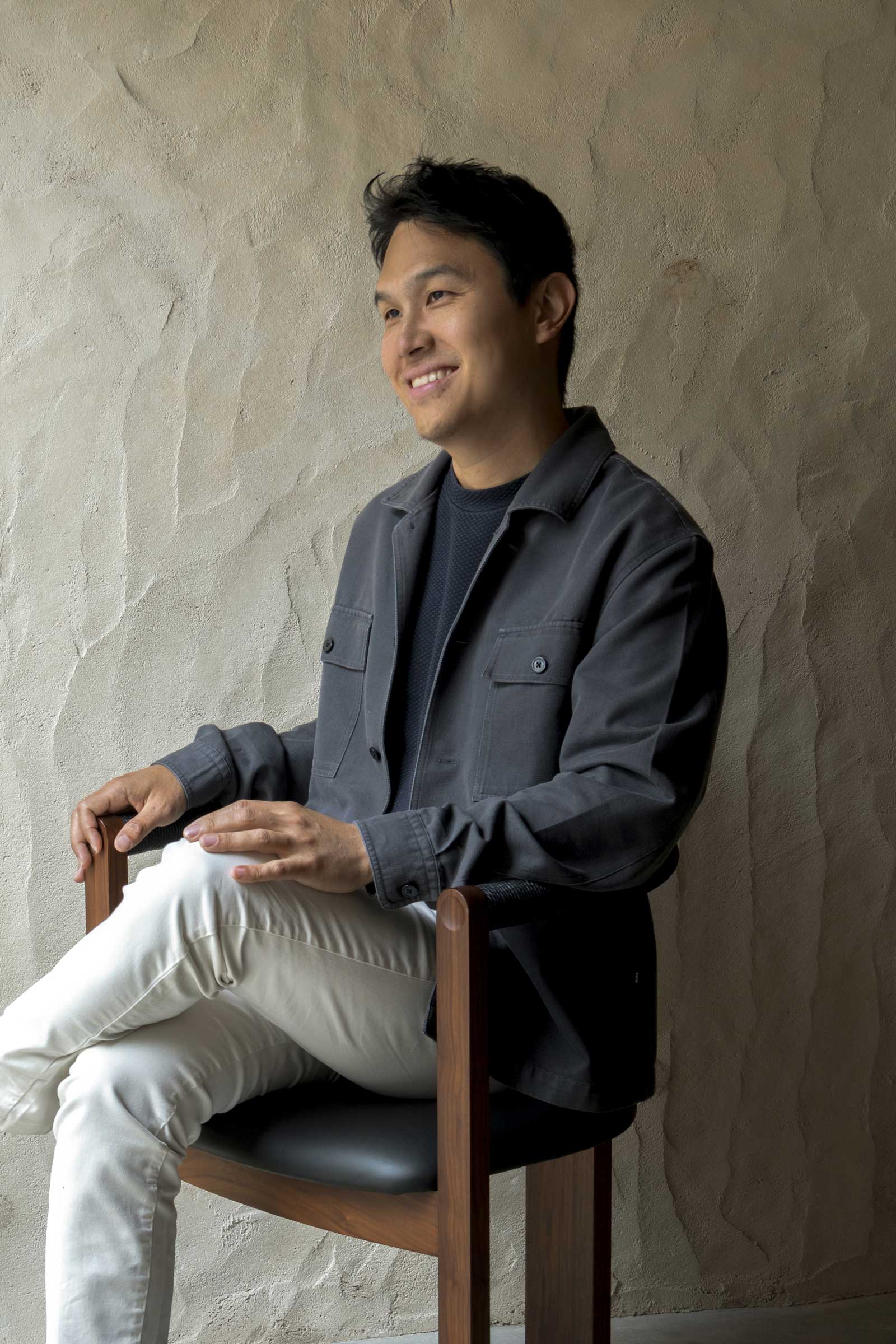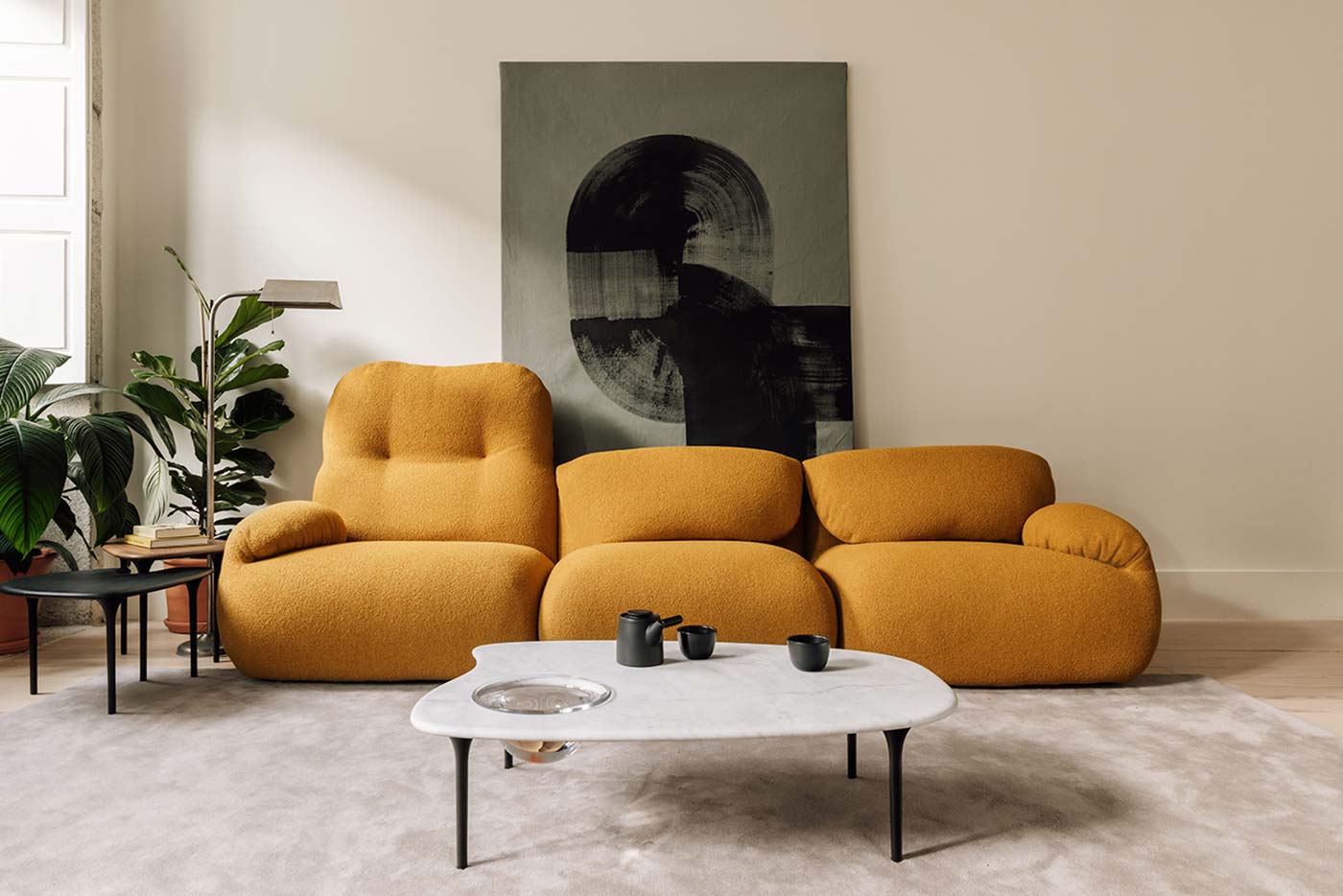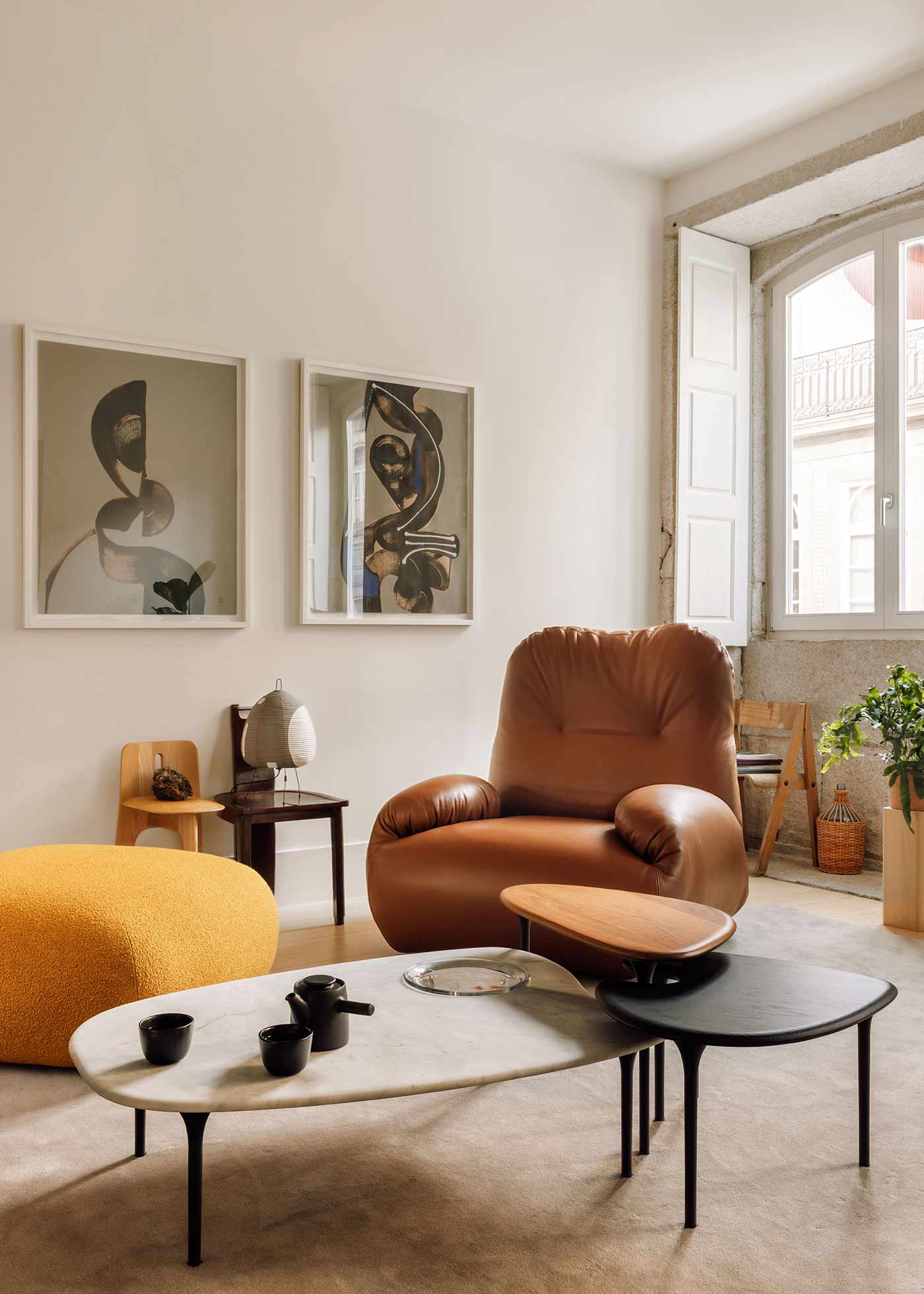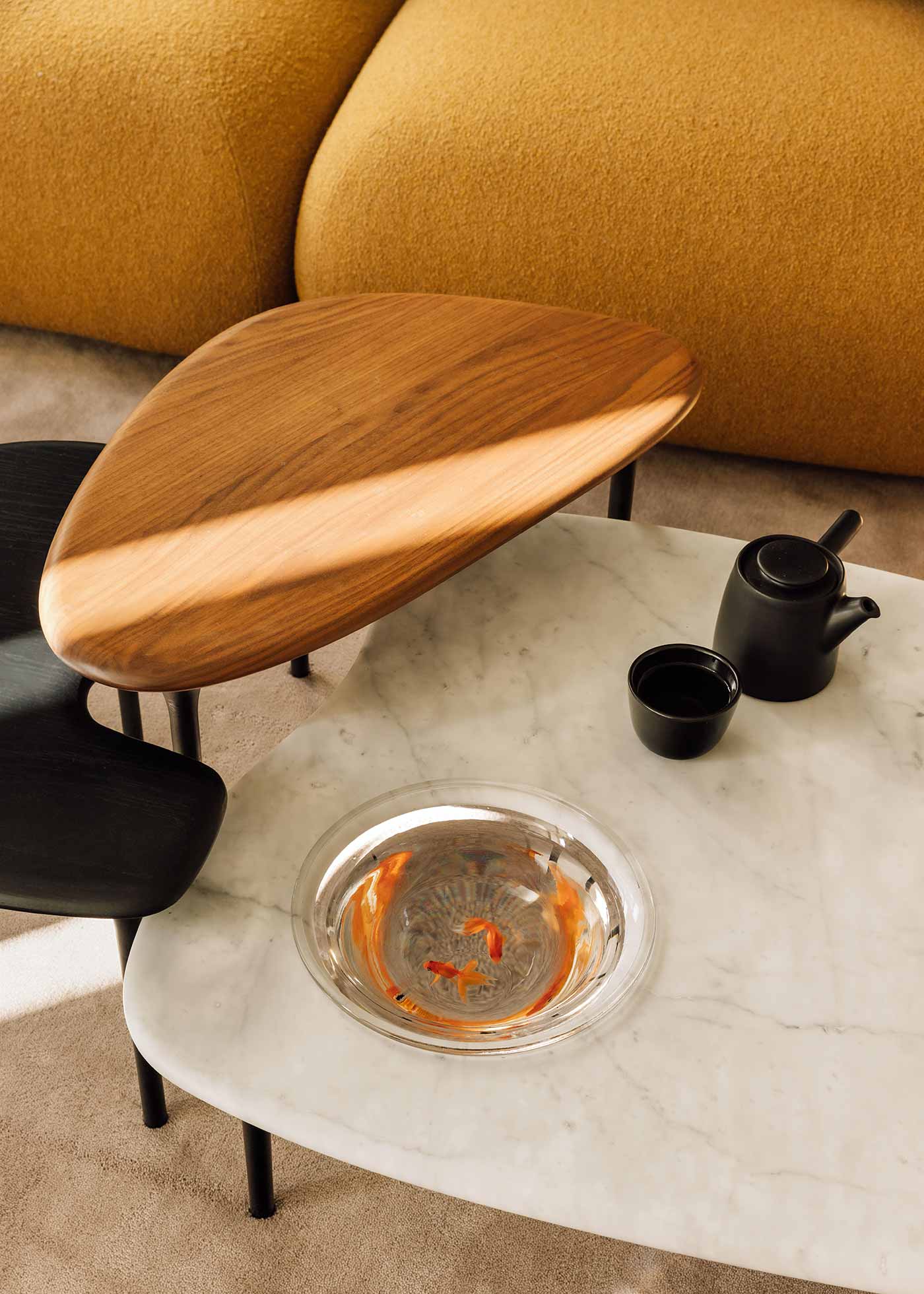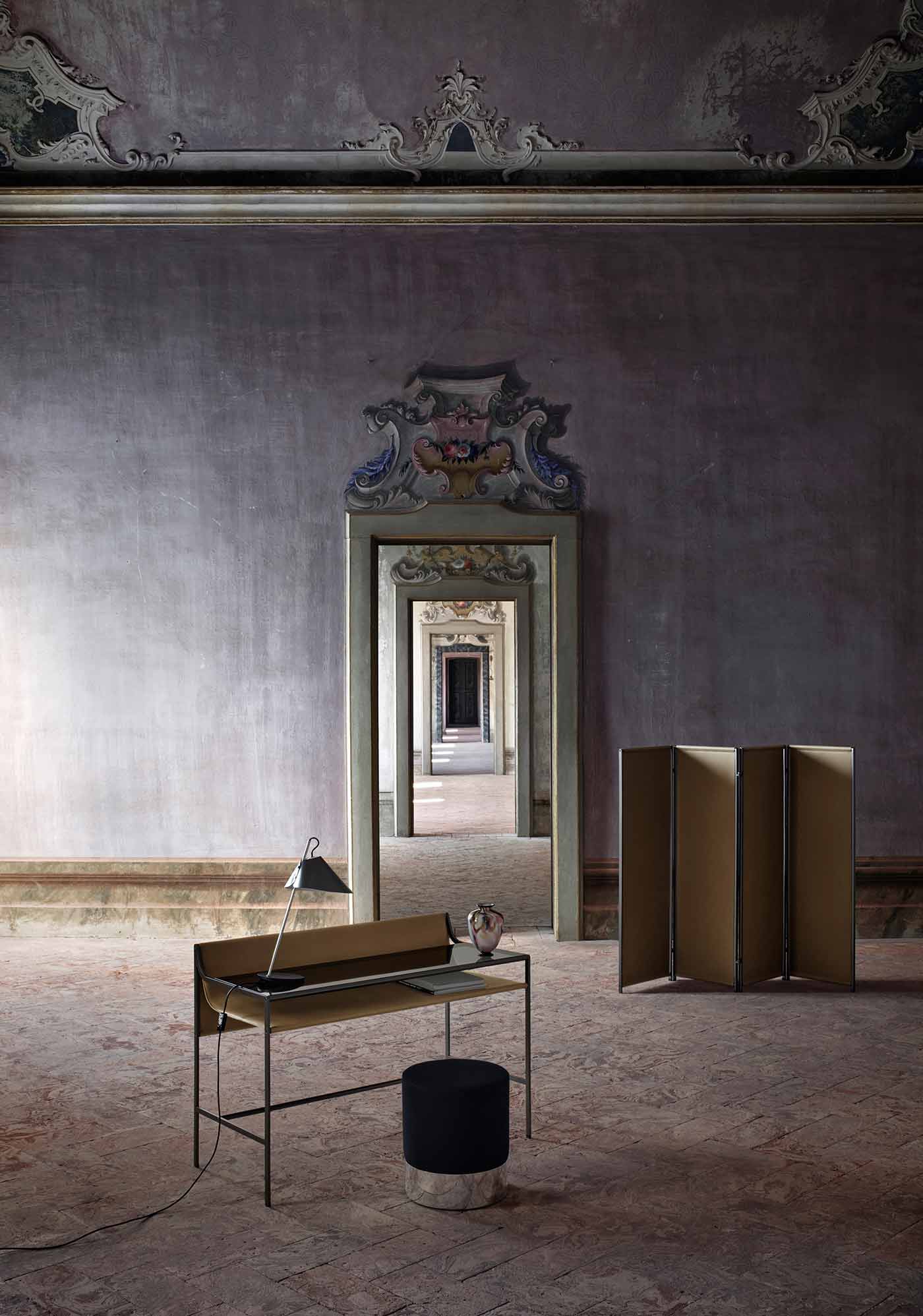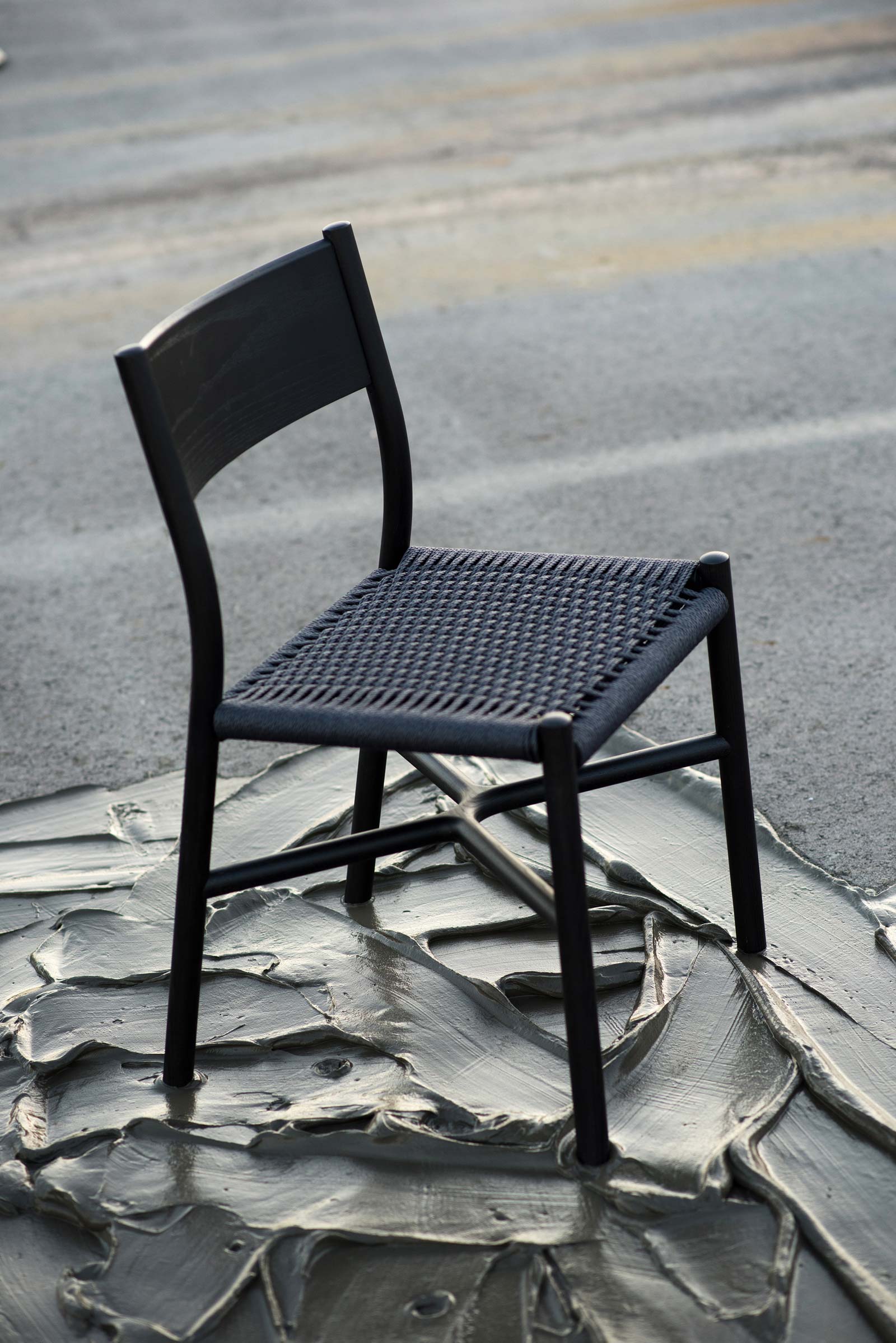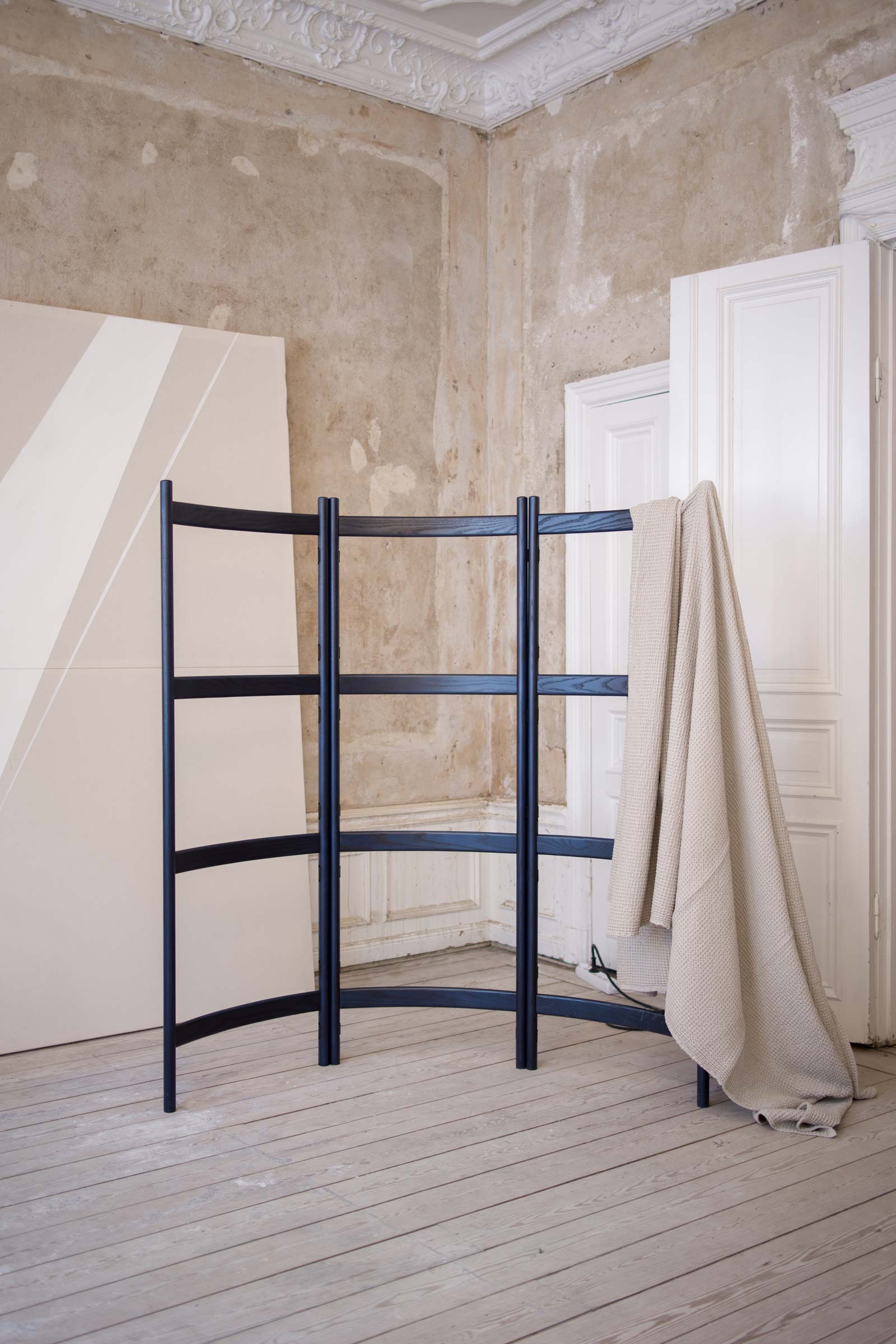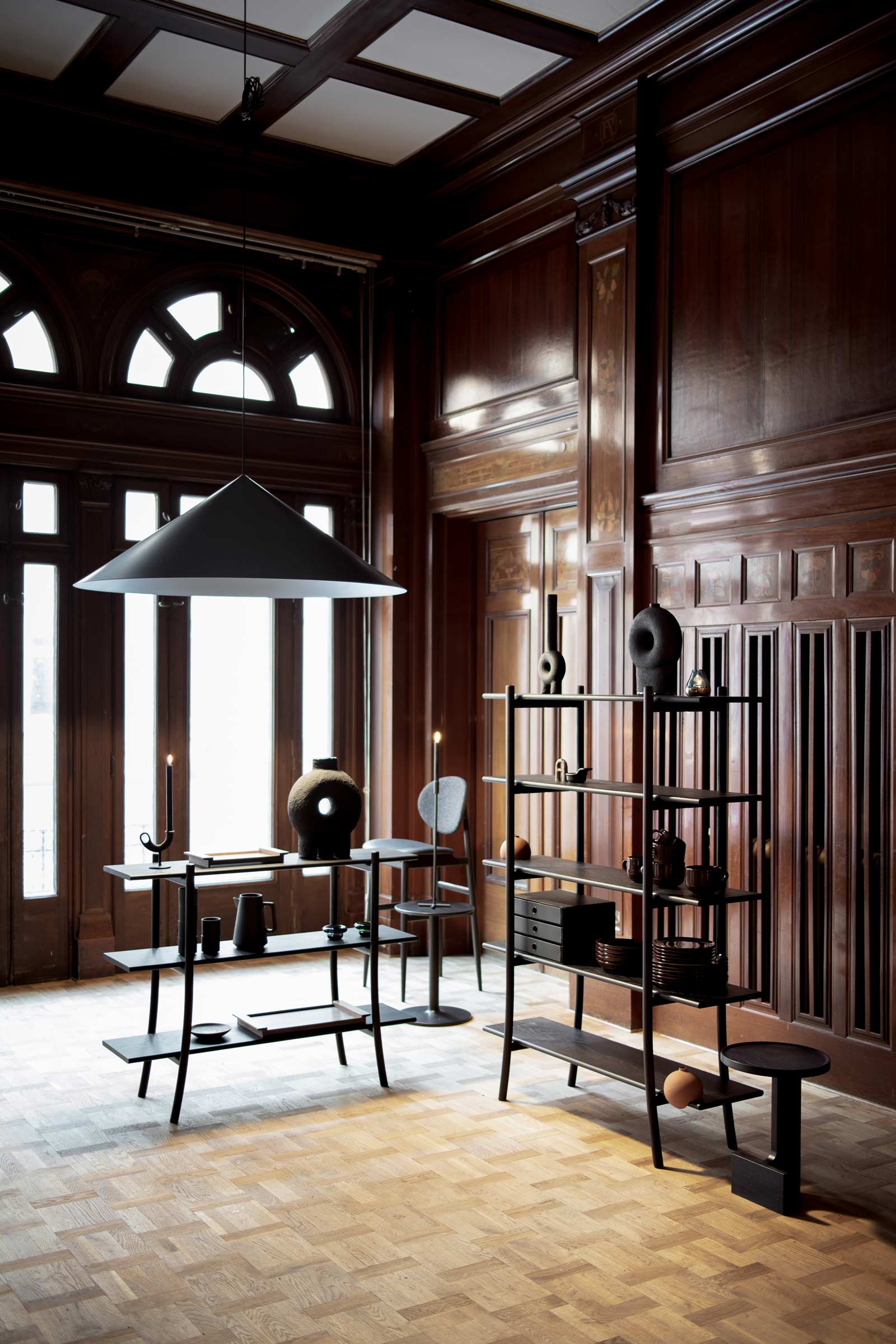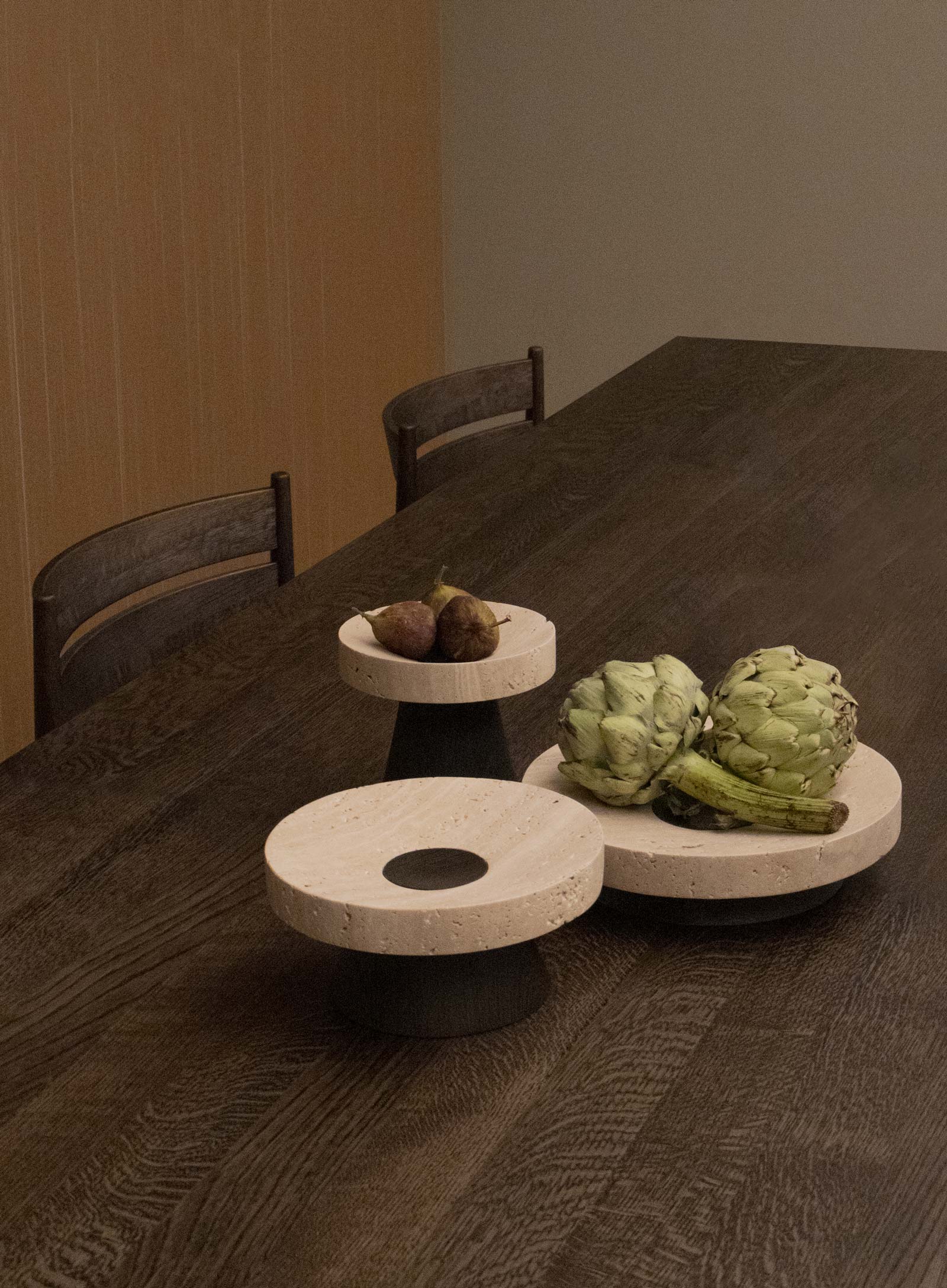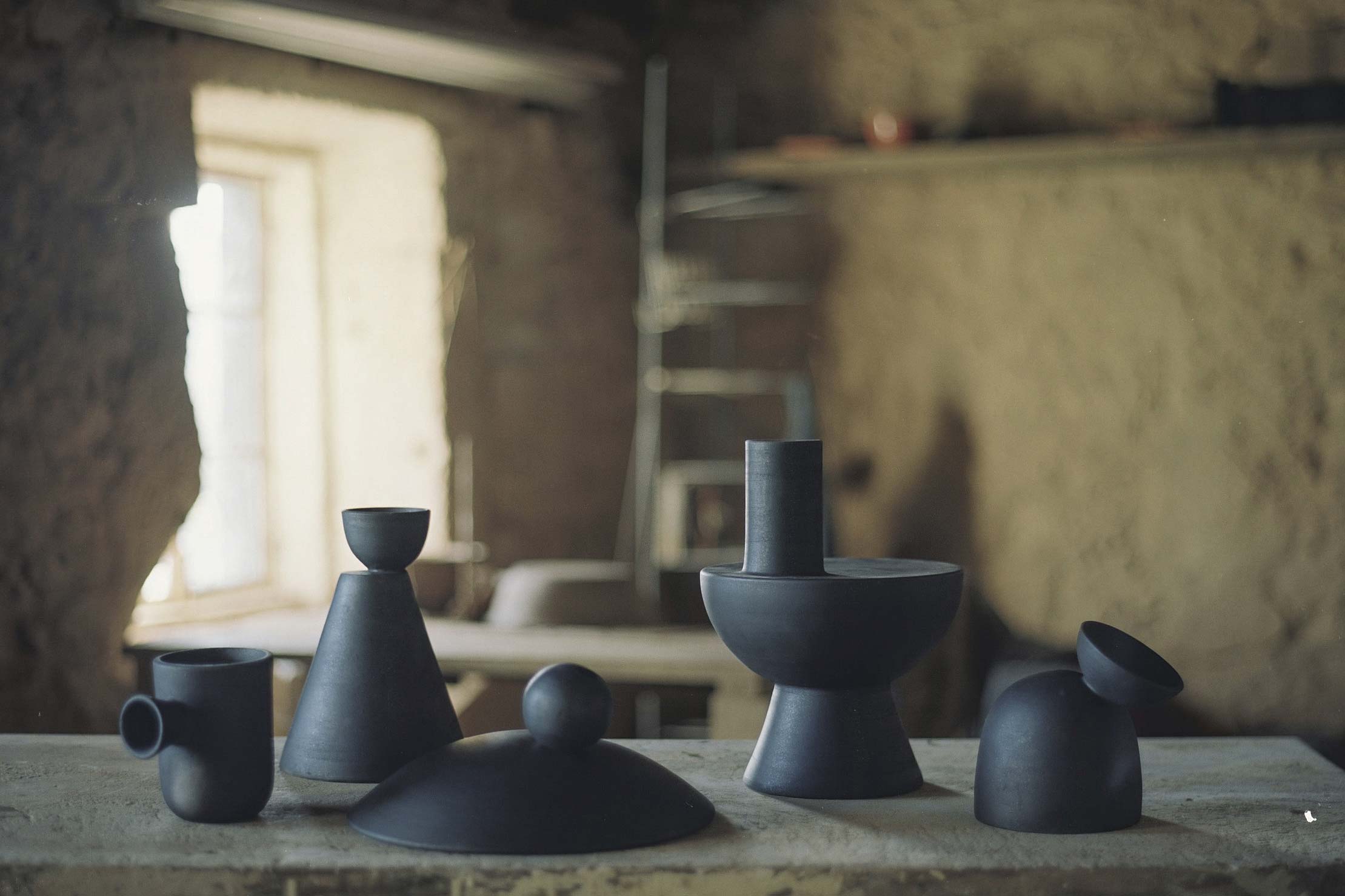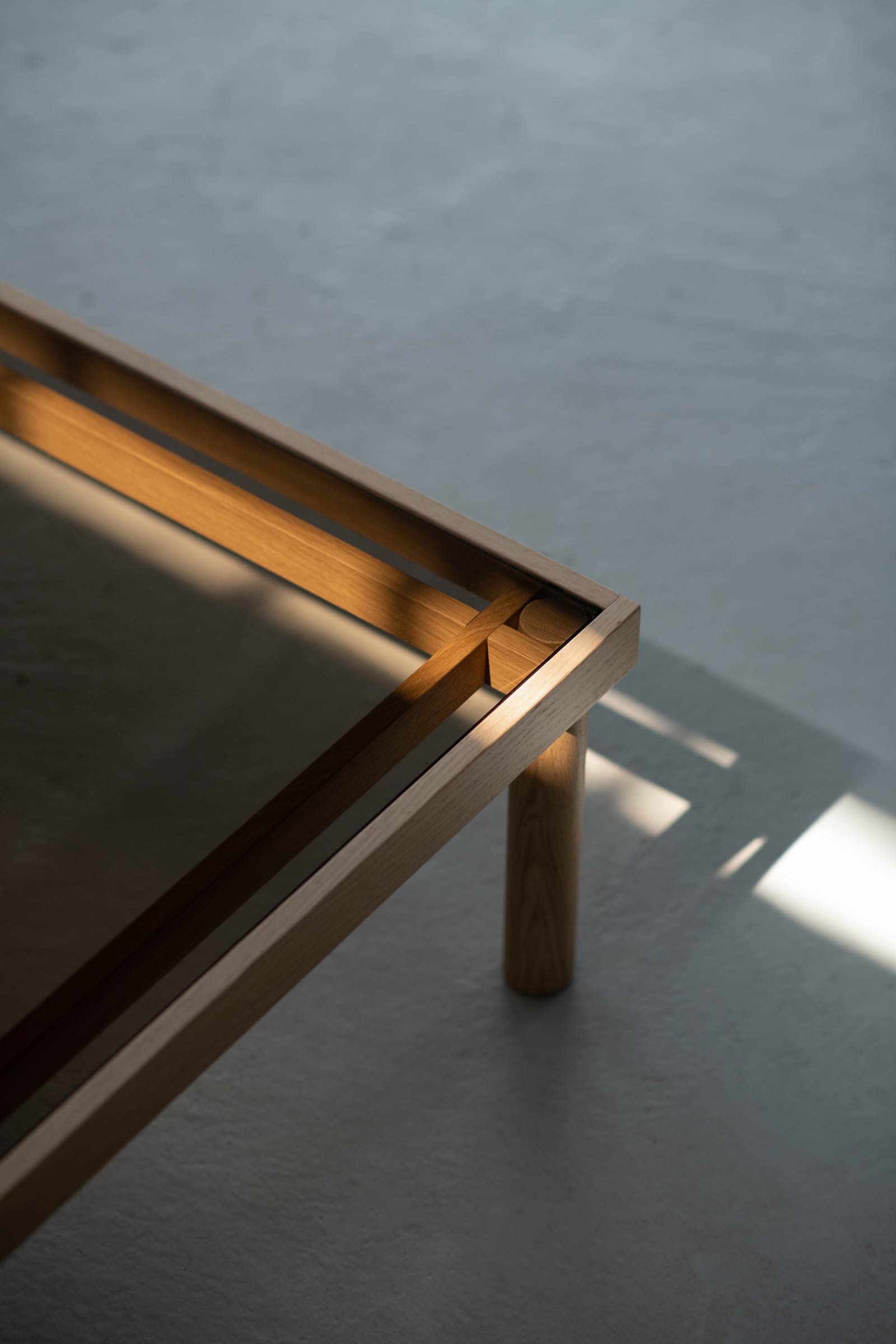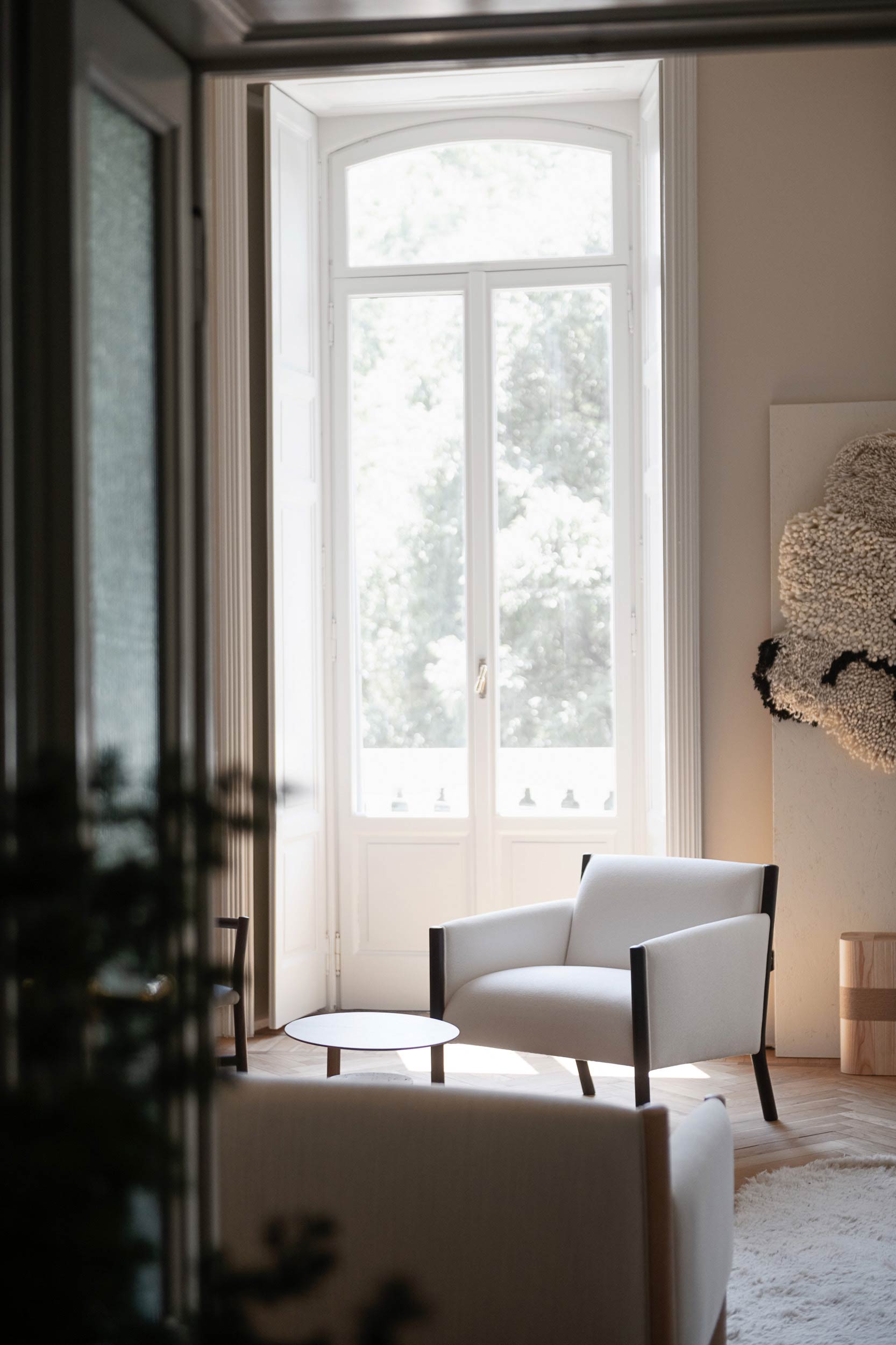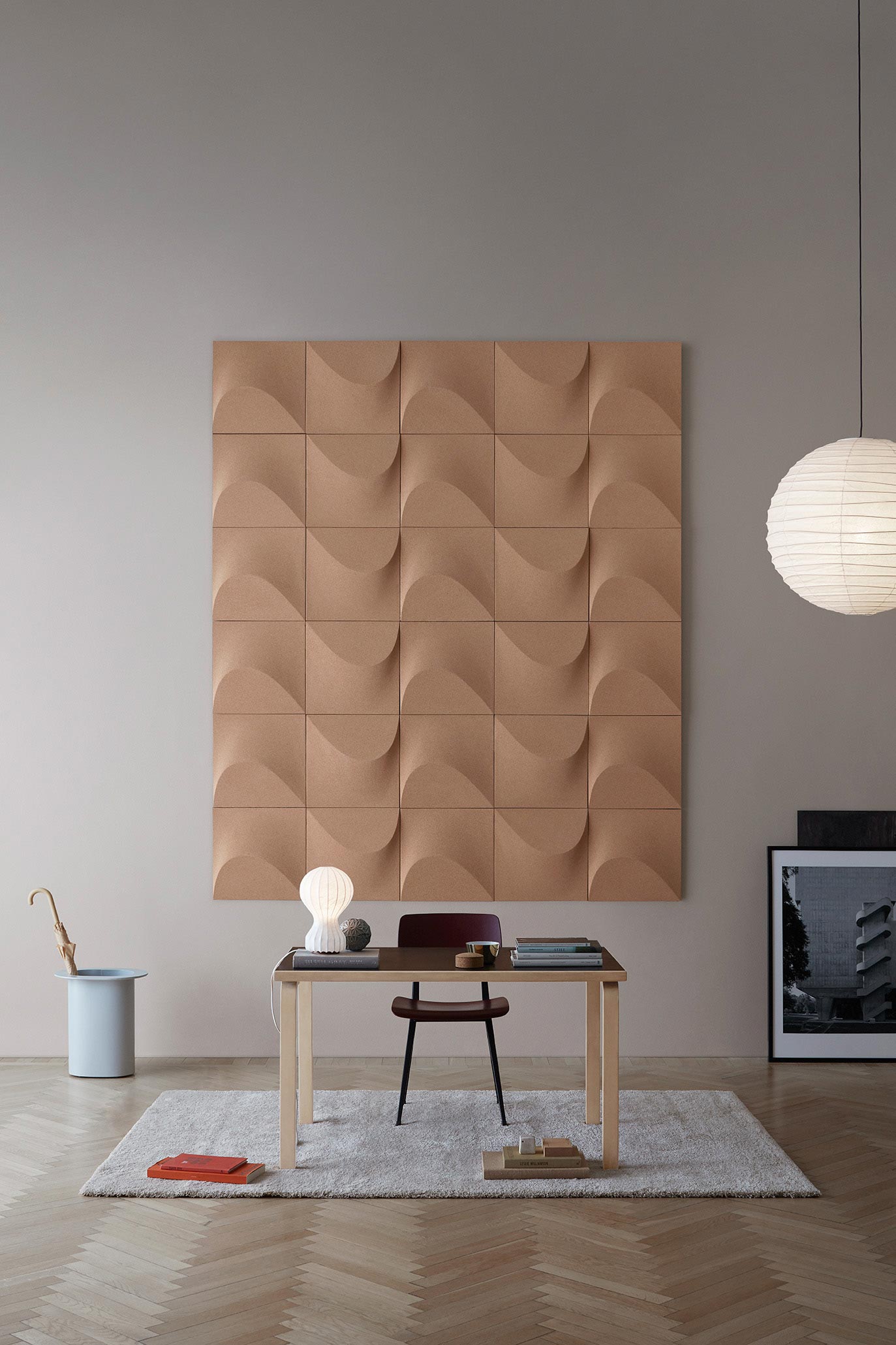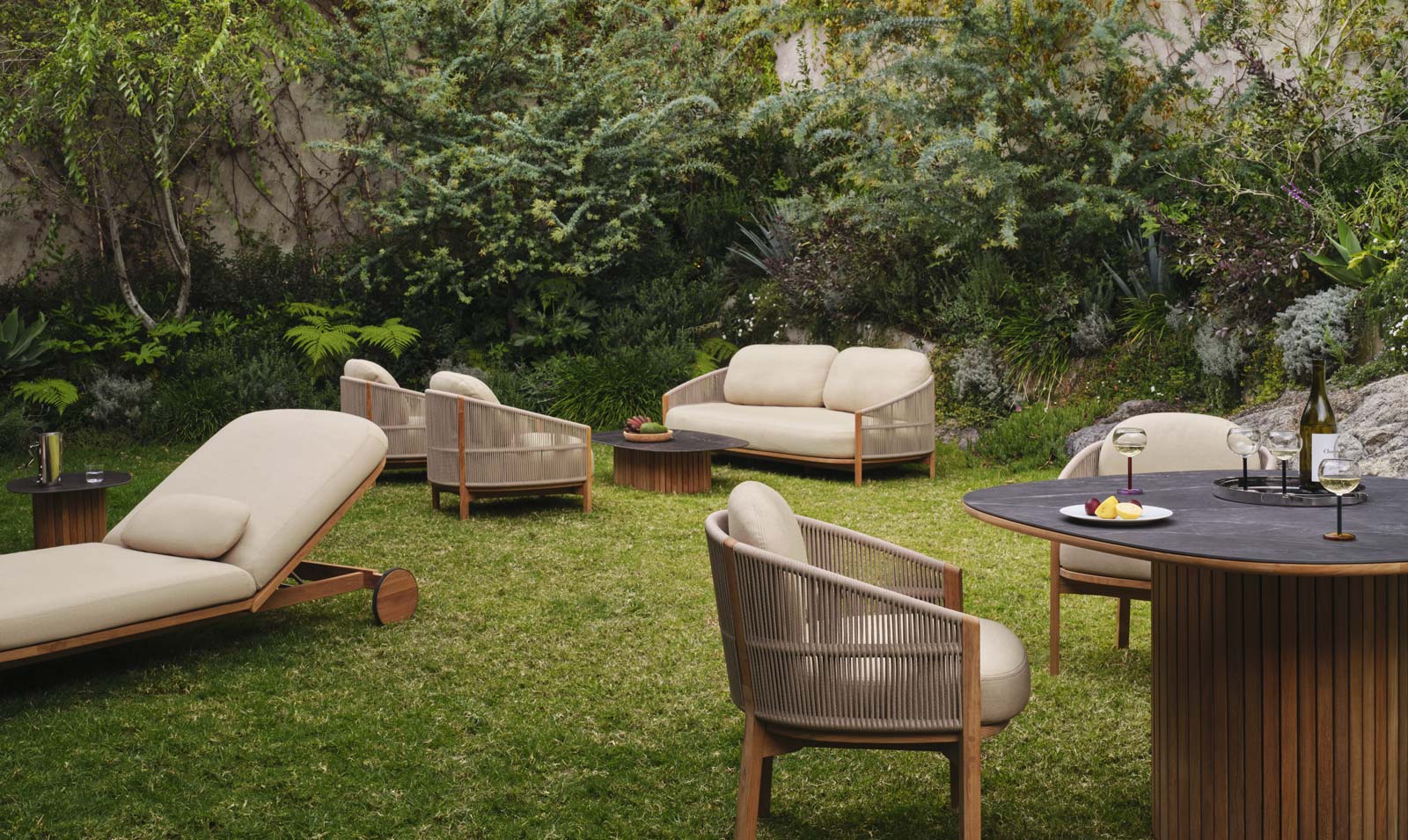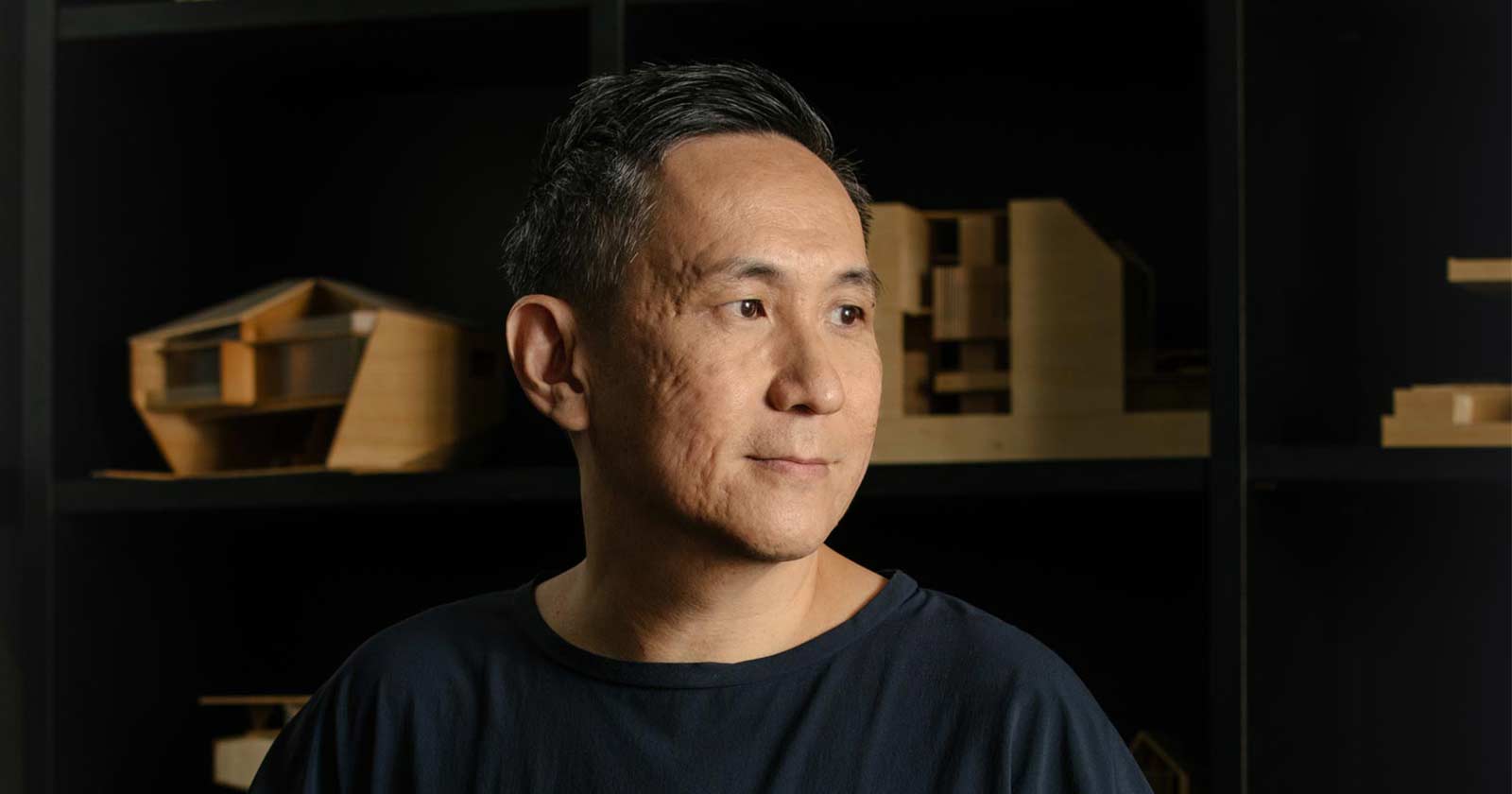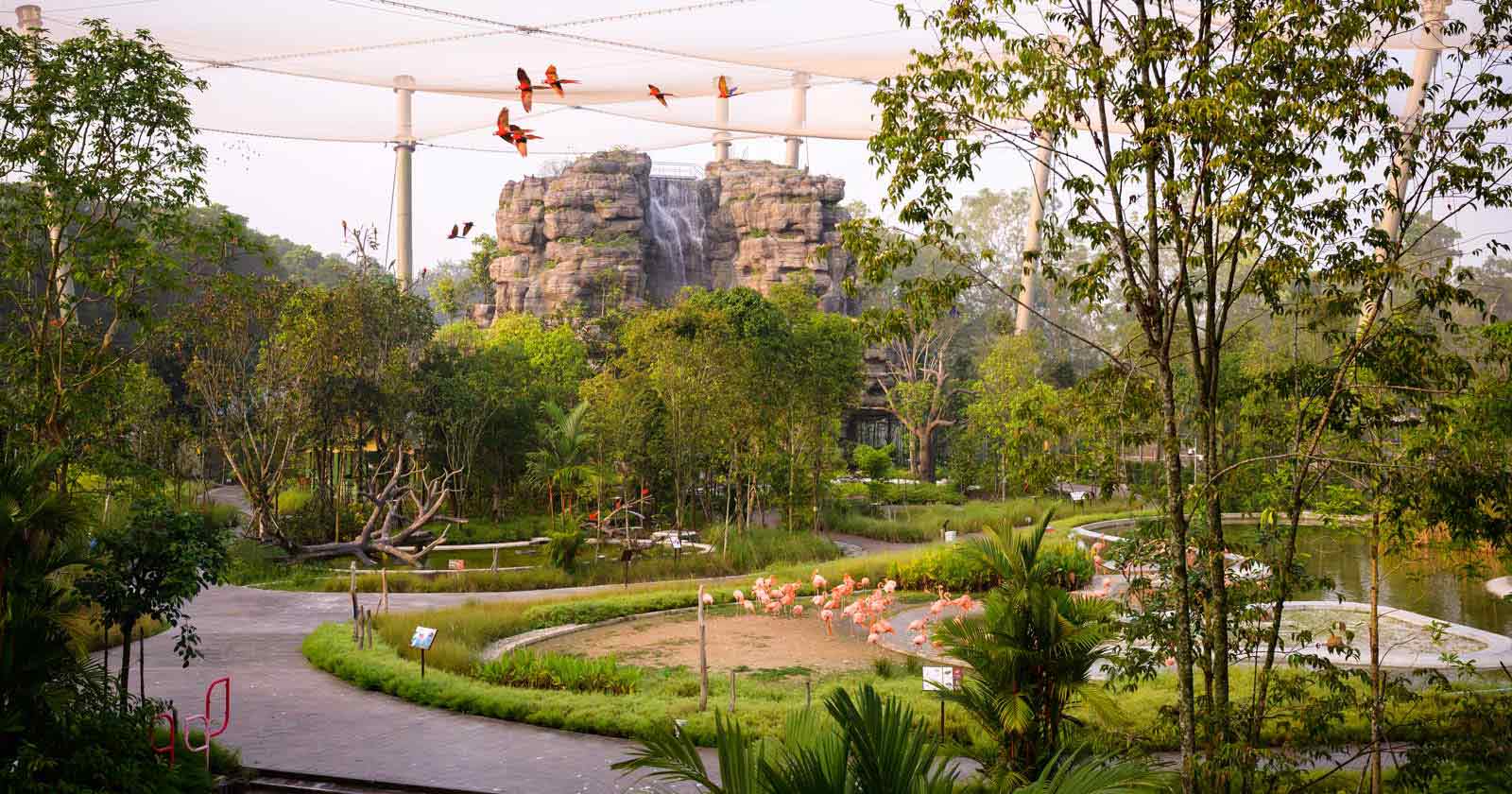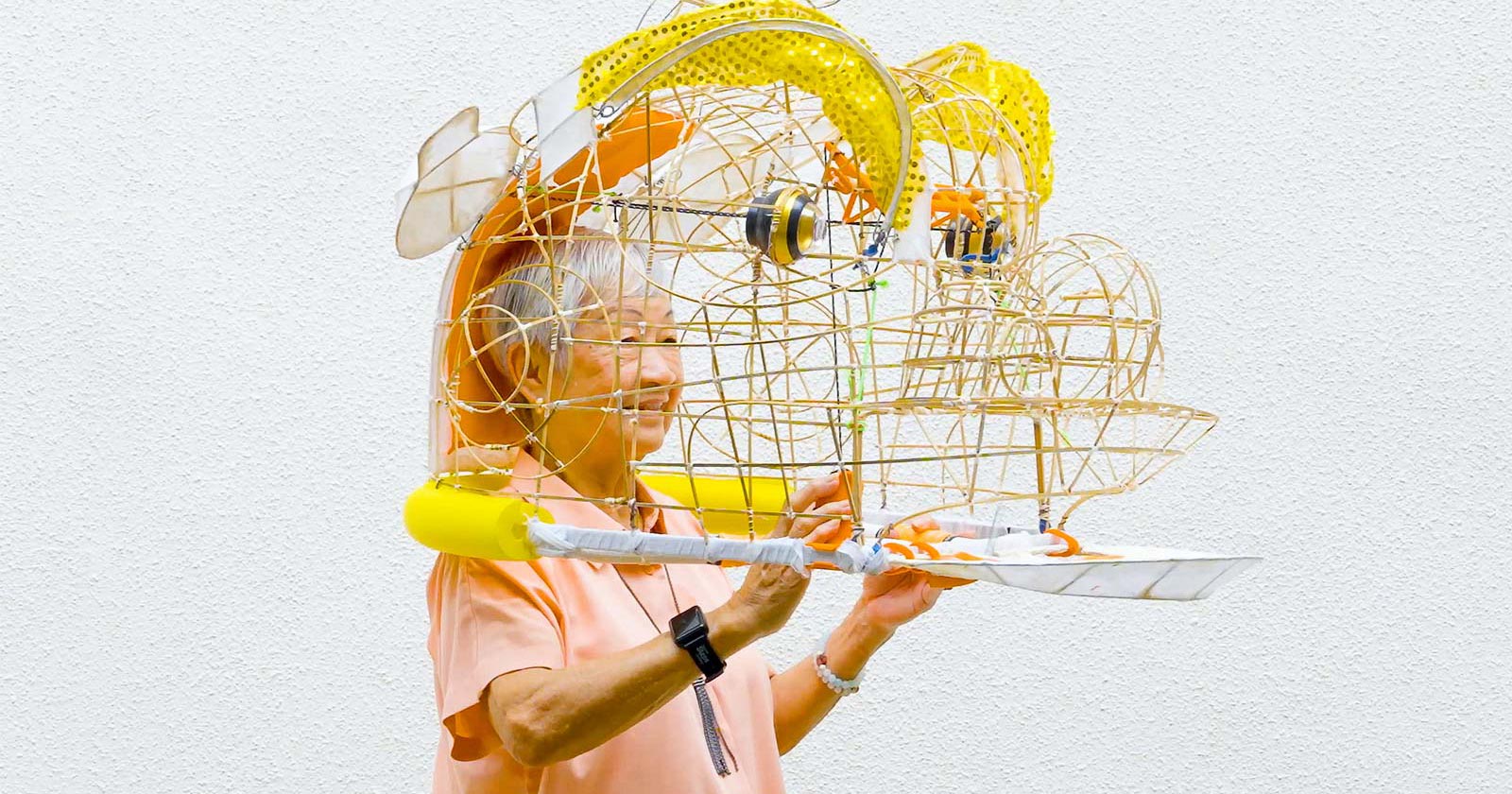DESIGNER OF THE YEAR 2025
Gabriel Tan
Principal, Gabriel Tan Studio
and Studio Antimatter;
Co-founder, Origin Made
CONTACT
[email protected]
The designers who have worked with globally renowned furniture and product brands Herman Miller (USA) and B&B Italia (Italy) include titans of the design world from the past and present. Alongside the likes of Charles and Ray Eames, Isamu Noguchi, Michael Anastassiades, and Patricia Urquiola, there is a sole Singaporean: Gabriel Tan.
Herman Miller and B&B Italia both released furniture designed by Tan in 2023. Just two decades earlier, he was fresh out of navy training and finding his feet in the recently established industrial design course at NUS. Poring over books on Noguchi and the Eames, mainstays of the Herman Miller catalogue, he never imagined he’d one day design for a brand that produced their work.
The fact that he has done so, and much more, is testament not only to his creative vision and design skill, but also a raft of attitudinal qualities that have shaped a successful design career in Singapore and beyond. Tan is characterised by his impressive stamina, entrepreneurialism, and professionalism, all of which are stoked by a burning curiosity for shaping meaningful and sustainable design outcomes.
When reflecting on his career path, Tan speaks with much gratitude for the decade he spent as a co-founding Design Partner of furniture, product, and lighting design studio Outofstock. The studio was established during the final year of his studies in 2006 with co-founders Wendy Chua, Gustavo Maggio, and Sebastian Alberdi. For 10 lively years, Outofstock was a springboard for learning the ropes together while gaining international exposure and building industry relationships.
Tan now wears multiple hats. He is the Principal of Gabriel Tan Studio, established in Singapore in 2016. The studio focuses on industrial design and works with Singaporean and international brands. He is also the Design Director of Antimatter, a residential and hospitality interior design studio he set up in the same year.
Further afield, he has been the Creative Director of Japanese furniture brand Ariake since 2016. In 2018, he co-founded craft-oriented design brand Origin Made with his wife Cherie Er. The Porto-based brand preserves the artisanal traditions of Portugal by fusing them with contemporary design sensibilities.
Tan and his family relocated to Porto in 2020, but he returns to Singapore regularly. Being based in the two cities enables him to draw influences from Asia and Europe. Unsurprisingly, his design practice explores cultural intersections, seeking new ways to interpret tradition, craft, and technology.
Today’s emerging Singaporean designers will, without doubt, look to Tan for inspiration as one of their own. He is someone who has achieved international success and developed fruitful business opportunities, all while producing designs of exceedingly high quality.
1GABRIEL TAN
Principal, Gabriel Tan Studio
and Studio Antimatter;
Co-founder, Origin Made
2DUAL INSPIRATION
Herman Miller released Tan’s Luva Modular Sofa Group (Luva) in 2023. Luva is Portuguese for “glove”. The sofa’s shape was inspired bythe soft grip and padded support of boxing gloves as well as rolled Japanese futons.
3ROLL WITH IT
The back of Luva can be rolled down to make a fist-like shape suited for chatting and working, or rolled up to form a more supportive backrest for relaxed lounging. It is pictured with Tan’s Cyclade Tables, also released by Herman Miller in 2023.
4NOD TO NOGUCHI
The Cyclade Tables emulate the form of Pangea and were conceptualised as islands that can be clustered or used separately. Each table is distinct in terms of height, tabletop shape, and material. The sculptural forms are a nod to the designs of Isamu Noguchi.
5SERENE SILHOUETTES
The Quiet Lines collection of bedroom furniture, including the writing desk and screen pictured, were released by B&B Italia in 2023. Curved, padded surfaces emphasise tactility and comfort while dampening sound when objects are placed on them. The pieces were designed for easy disassembly and repair.
6DEEP INDIGO
Tan designed the Ariake Chair for Ariake as one of the new brand’s first products. Released in 2017, it helped set the vision for Ariake’s design character, balancing delicateness and strength while emphasising wood joinery details. Under Tan’s creative direction, Ariake introduced distinctive wood finishes including Japanese sumi (ink) and aizome (indigo dyeing).
7DELICATE DIVISION
The Shoji Screen was released by Ariake in 2018. It can be used as a spatial divider or folded into a coat rack. Its wooden components are steam bent. The hinges, set flush within the verticals, are made with elastic canvas straps.
8GENTLE CURVES
The design of the Skyladder Shelves for Ariake (released in 2018) was inspired by the fireworks installations of Chinese artist Cai Guo-Qiang and the rope ladders suspended from hot air balloons. Japan’s Saga Prefecture, where Ariake is based, holds a hot air balloon festival annually.
9HALF MOON
Origin Made released the Meia Lua Armchair in 2023. Meia lua is the Portuguese term for “half moon”, a reference to the crescent-shaped three-legged chairs of the 1950s that inspired the armchair’s design.
10TIMELESS STANCE
The Coliseu Pedestals are functional sculptures. Released by Origin Made in 2022, their design was inspired by the amphitheatres of ancient Rome. They are crafted with wood and travertine, forming a seamless concave surface.
11CRAFT TRADITIONS
Designed for ikebana flower arranging, the Charred Vases (Origin Made, 2020) are unique ceramic forms fired with the traditional Portuguese technique of barro preto (“black pottery”). Smothering the ceramic with earth during firing produces a non-homogenous texture of black, grey, and earth tones.
12STRUCTURAL REVEAL
Taruki means “roof rafter” in Japanese, and the Taruki Coffee Table for Ariake (released in 2022) offers a reinterpretation of traditional Japanese roof joinery. The inset smoked-glass tabletop reveals the structure of the table as the key visual element.
13LIGHT TOUCH
Visual lightness was the goal for the Rin Lounge Chair, released by Ariake in 2020. The Japanese word rin means “dignity and elegance”, and the form of the Rin chair emphasises compact upholstered planes that seem to hover above the floor.
14SOUND DUNES
Waste material from the production of wine corks at a Portuguese factory is transformed into acoustic Sahara Wall Panels by Swedish brand Abstracta. The sculptural panels, released in 2019, can be arranged in many ways to create a variety of patterns.
15SOFT ISLANDS
The Softlands Collection of outdoor furniture for Design Within Reach was released in 2024. Tan’s goal was to create “soft islands” that would feel like private getaways. The rounded, sheltering shapes and low, lounge-like seats convey an aesthetic of comfort.
Insights from the Recipient
GABRIEL TAN (GT): I took a naval scholarship, which meant I would be a Navy Combat Officer for five years. While I was training, I went to borrow some books from the National Library, and I stumbled upon the design section. I was fascinated by books about designers like Philippe Starck and their work in furniture, objects, and lighting.
At the same time, I saw an advertisement in the newspaper for the new industrial design programme that had just been started by the Department of Architecture at NUS. It was such a coincidence, and I wanted to apply for it.
I had already been accepted into a business administration course. But when I wanted to switch to industrial design, the people from Naval Human Resources told me it wasn’t possible because it was a new programme and they didn’t know how long it would take to be approved. After a lot of discussion, they agreed to release me from my contract.
So right from the beginning, even before I started studying design, it was a fight to get there. That made me value the profession more because there had been obstacles in my way.
GT: When we started Outofstock, we thought we would continue working together throughout our careers. It was great dividing the work, brainstorming, and iterating things together. Formal education only prepares you for your career up to a certain point, and that was especially the case for furniture design because it wasn’t something the university specialised in.
To gain experience in this field, there was a lot of peer learning, visiting factories, and learning from the people who were actually producing furniture. The four of us were growing together and helping each other improve in terms of experience and confidence in the industry.
After 10 years, it was time to take the next step, but we all wanted to go in different directions. Some of us wanted to do more research and take on deeper projects. I personally wanted to do more furniture and product design. So, we decided to go our separate ways.
It was not easy in the beginning, especially in 2016, when I had to start again on my own. But it was an opportunity to reset my clients as well, to go for totally new ones. The experience of having already been in the industry for 10 years and working with good companies in Europe gave me the confidence that I could do it again.
GT: I got to know a lot of people during those early years when we were showing in Milan and when we subsequently travelled to different fairs together. If I hadn’t spent those early years with Outofstock, I wouldn’t have met this global circle of designers and companies that we encountered along the way. Even if we didn’t collaborate back then, it helped that I could approach these people after I started my own studio.
You know, not everybody ends up pursuing their own studio. Some designer friends of ours went in-house in different industries. Some became creative directors, some became product development managers, others became independent designers. We’ve helped each other over the years.
GT: I have always been interested in tradition and technology. That includes preserving what is great from the old world, like culture, craft, heritage, and traditions, but at the same time working with the latest developments in materials and manufacturing technology. I wanted to take on a new perspective on tradition and technology. That could mean reinterpreting craft traditions using new formats of production or finding an application for new technologies through design.
In some ways, I see the craft traditions of the world as belonging to all of us. They don’t belong to just one country. It is our duty to preserve them, no matter where they originated from. That brought me to Portugal because I felt like there was a lot of potential here in the craft industries.
In Singapore, we never really had this. I’ve worked with some local craftspeople like the J. Meyers Company, who are leatherworkers. We did some nice collaborations. I’m still working with Turn Handles, which is a door handle brand established in Singapore. But I went overseas because I felt like I needed to be further stimulated and pushed to grow.
GT: They were showing at the International Furniture Fair Singapore in 2016. They were one of the only Japanese exhibitors there. The furniture was very finely crafted and exotic, but it didn’t seem like something you could use in a contemporary home. I was attracted by how well it was made, and I was very curious.
So, I spoke to them at the Fair and showed them my work, and they were interested in collaborating somehow. There were two factories sharing the stand. They’d been trying to export for years without much success, and they viewed Singapore as the first stop for export because of its proximity to Japan.
They invited me to visit their factories, so I booked a ticket to Japan at my own expense, and we had a discussion about whether my studio could design for both factories. They suggested I design two products. I was very excited at the prospect of having two clients immediately after starting my own studio. But then I questioned if that would really benefit them. The answer was probably not. So, I took a night to think about it.
We had another meeting in the factories the next day, and I told them I thought they needed something bigger. If they had just two of my products in their catalogue, it would probably not make an impact because you wouldn’t feel much change to their offerings. They needed a new collection of at least 10 products to begin with, adding three or four products every year until it grew to a sizeable catalogue. They’d need a new website, new photography, maybe even a new name. I suggested they establish a brand that both of them could own.
They agreed and I managed to get this off the ground with a tiny budget by inviting some designers I knew to get involved. They all said yes, and that’s how we started. I also invited a graphic designer and photographer, so we’d have a melting pot of creatives from a number of different countries coming together. One of the designers I invited was Japanese. The idea was that we could all give our own take on Japanese design through the eyes of the world.
I learned a lot through that project, and it reinforced my feeling that we should always challenge the brief given to us as designers. Designing the process is often more important than designing the product itself.
GT: It was not. Life in Singapore was super comfortable. We were a dual-income family. My wife, Cherie, had a really good job and big responsibilities. But she wanted to do something creative for herself. So, when I floated the idea of moving, she was open to considering it.
We considered various places, but in the end, we chose Portugal because the craft and furniture industries here were still very much alive. We could build our own brand that Cherie would run as CEO, and I would creatively direct using the knowledge and experience I’d gained working with other companies in the past.
There is a humble craft culture here. People tend to not see as much value in their craft, as compared to their counterparts in Japan or Italy, for example. When we were looking at Portugal in 2017, there was this feeling that it was underrated and under-promoted. There are a lot more projects promoting crafts in Portugal today.
We moved here in 2020, but I’d been working on Origin Made since 2018, visiting suppliers and finding the right partners. I spent time convincing makers that what they’re doing really has value, and that we can make something good together. We finally launched the brand in 2019.
GT: Consumers generally have a certain perception of the value of things. They might look at a basket and think it is worth $50, even though the hours spent weaving it might be worth much more than that. So, the craftsperson sells theproduct for $50 because that’s the maximum the market will pay. This is the problem. Craft is dying because makers know they won’t recover the value of the hours they invest.
Through design, we can introduce a different expression of craft, so people feel it is new and unique. The challenge for us is then to make sure the craftsperson receives a fair value for the number of hours they put in. That challenge is what keeps us going. It isn’t easy, but it’s what can keep craft alive and sustainable.
GT: We don’t take shortcuts. For example, we work with the traditional Portuguese clay firing technique called barro preto (black pottery). It uses an earth kiln, so you get an iridescence and rawness that you don’t get if you use an electric kiln. There are companies here that are doing modern barro preto using electric kilns, but the effect is completely uniform and homogeneous. We could probably make a much bigger profit and produce it faster if we did that too. But by doing it the old way, we keep the tradition alive.
GT: People say they enjoy working with us because we’re professional, we’re quick, and we deliver products with high quality. It’s not just about the final design, but everything from the initial sketches to the three-dimensional files. We don’t just give them a hand sketch and leave the rest for them to figure out. That makes it much easier for companies to collaborate with us. I think it’s all about having the right attitude to work, being super professional, and working fast to deliver.
I didn’t go to an A-list university in Europe and even though I went through a very good programme, it has not aligned with the things I’m doing now. It was skewed toward working in consumer electronics or medical design. So, I really had to fight to achieve my goals. I needed to gain knowledge over the years in order to reach a level that would even interest these companies.
This is something to be proud of, but I still want to grow and learn more as a designer. I want to work with the best in lighting, outdoor, and other fields that I am not involved in as much today.
GT: It is important that our designs bring comfort, or better social interactions, or better awareness of sustainability questions. We try to bring something different to the table such that it’s not a banal experience of a product, but feels unique and satisfying in different ways.
For example, the Sahara Wall Panel we designed for the Swedish brand Abstracta is made using cork waste from wine stoppers. They show people that even recycled or upcycled materials can be contemporary and sit comfortably in a high-end environment.
With the Luva Modular Sofa Group we designed for Herman Miller, we wanted to design the most comfortable sofa on the market. We felt we achieved that through a lot of research and development, alongside many steps of prototyping, to ensure that it is comfortable in both open and closed positions.
GT: As Singaporean designers, we don’t have any cultural baggage. We can explore any topic we want because there is no expectation of what designers from Singapore should design. We’re not like the Scandinavians, who are often bound by expectations of minimalistic expression or sustainability-focused design. A Japanese designer trying to do something super decorative will find it very hard to position themselves because there’s an expectation of something Zen.
As a young designer from Singapore, you can really follow your own calling and try to find a position in the industry that makes sense to you. But it’s important to understand the exposure needed and the learning curve to get there. Things are not going to happen right away.
When I first started exhibiting at Salone Satellite in Milan, I wondered why our stuff was not getting produced in the first two years. It took a lot to come back to show again in the third year, when I had no results prior. The truth is, it’s like the experience of sports people. Some people are early bloomers, some are late bloomers, and you cannot assume that late bloomers have no talent.
Often, the talent is there because people take time to put hard work into it. Beyond the glossy magazine profiles on designers who have made it, there are countless hours of investment that these people have made in themselves to reach that point. So, my advice would be to think in terms of decades rather than years.
Citation
Jury Citation
Nominator Citation
Tony Chambers
Founder and Director, TC & Friends
Gabriel Tan’s work exemplifies the highest standards of craft, innovation, and an entrepreneurial spirit on the global stage. A self-made designer with a focused and internationally recognised portfolio, Tan has successfully bridged cultures and disciplines, collaborating with leading brands such as Herman Miller, B&B Italia, and Ariake.
His deep engagement with traditional crafting – from Japanese timber to Portuguese artisanship – demonstrates a profound respect for heritage while pushing the boundaries of contemporary design. Despite being based in Portugal, Tan maintains a presence in Singapore, where his contributions to the design industry serve as an inspiration to emerging talent.
His journey, from co-founding Outofstock to establishing his own brand, Origin Made, showcases his vision and resourcefulness in building a design practice that is both commercially successful and culturally significant. With a strong body of work recognised internationally, he has made a significant mark everywhere he has been, flying the Singapore flag high on the global stage.
Tan represents the very essence of a global Singaporean – a designer whose work speaks to international audiences while remaining deeply connected to his roots, making him a deserving award recipient and a role model for future generations.
I have been aware of Gabriel Tan’s work since he graduated from NUS in 2007, and I’ve known him personally since around 2016. In that time, I have been fortunate to witness how this talented designer has combined his creative drive and flair with an entrepreneurial spirit and smart business acumen to become one of the key names to watch on the global design stage.
Gabriel’s innovative and sustainability-focused approach to design and manufacturing, along with his tireless work ethic and boundless curiosity, has endeared him to all areas of the profession, from the clients he works for to the teams who work for him. His positive impact on the design profession is hugely significant.
I think Gabriel would be a worthy recipient of the President*s Design Award 2025 for the reasons outlined above, but also because he is one of the very best ambassadors for Singapore design.

